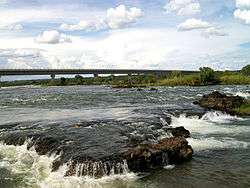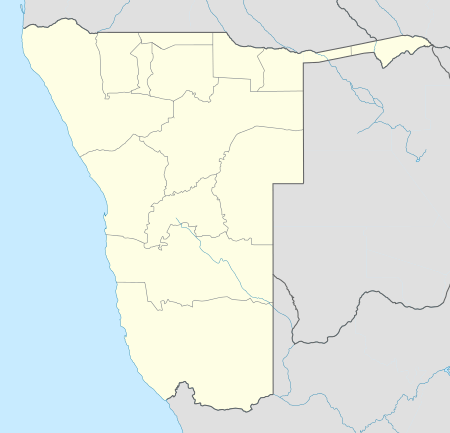Katima Mulilo Bridge
| Katima Mulilo Bridge | |
|---|---|
 | |
| Coordinates | 17°28′18″S 24°14′59.73″E / 17.47167°S 24.2499250°ECoordinates: 17°28′18″S 24°14′59.73″E / 17.47167°S 24.2499250°E |
| Crosses | Zambezi River |
| Locale |
Katima Mulilo, Namibia Sesheke, Zambia |
| Characteristics | |
| Total length | 900 metres (3,000 ft) |
| Number of spans | 19 |
| History | |
| Constructed by | Concor |
| Inaugurated | 13 May 2004 |
 Location in Namibia | |
The Katima Mulilo Bridge (also known as Bridge 508 in the Namibian Bridge Register) carries the TransCaprivi Highway over the Zambezi River between Katima Mulilo, Namibia and Sesheke, Zambia. It is a road bridge, completed in 2004, 900 metres long and with 19 spans.[1] It links Namibia's Trans–Caprivi Highway to the Zambian road network, forming a section of the trade route from south-central Africa to the Atlantic known as the Walvis Bay Corridor. It is also intended to carry tourist traffic.[2]
Plans for the bridge were first considered in Namibia in 1982, and the number 508 was allocated to the project. However, the occupying South African government was opposed to the project, and only after Namibian independence was planning resumed in 1990. In 2002 the contract for construction was awarded to Concor of South Africa and Hochtief of Germany, with the bridge completed on schedule in 2004. The bridge was constructed using the German technique of incremental launching (Taktschiebe-Verfahren), with the deck of the bridge constructed on location then hydraulically pushed segment-by-segment across the river.[1]
The bridge was officially opened by the President of Namibia, Dr. Sam Nujoma, and President of Zambia, Levy Mwanawasa on 13 May 2004, in Katima Mulilo.
See also
References
- 1 2 Website of Dr. Klaus Dierks , first Deputy Minister for Works, Transport and Communication in independent Namibia, involved in the planning and negotiations for the bridge, accessed 15 February 2005.
- ↑ Speech of Dr. Sam Nujoma at the bridge's opening ceremony, as published on the Government of Namibia Network, accessed 15 February 2005.